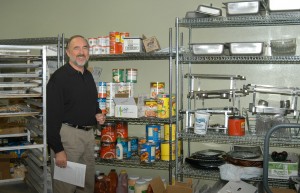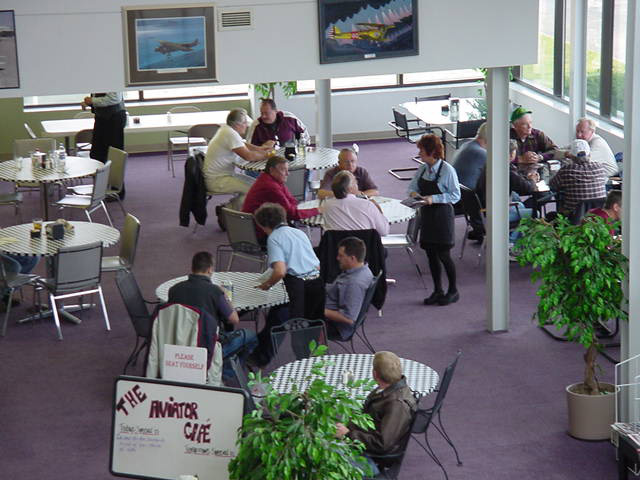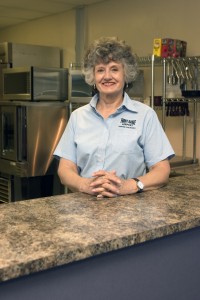
Hangar talk abounds in the café’s seating area, which is a popular lunch spot for both pilots and locals.
By Shari Valenta
As long as there are clear skies and single-engine aircraft, aviators will use food as an excuse to fly somewhere—hence the term “$100 hamburger.” Dennis Heap, executive director of aviation at Front Range Airport (FTG), is confident that the recently opened Aviator Café will be such a destination.
Front Range’s airport terminal became operational in December 1985. A spacious lobby area—with lots of windows, for light and views of the ramp—was incorporated into the design. Knowing that food service was essential to growth, the terminal included a snack bar, with a small kitchen area and seating for 24 people.
A third party was allowed to operate the snack bar, at no cost, as a service to airport customers. But operators rarely stayed in business for more than six months, as they soon found it was a challenge just to break even on food, let alone personnel cost. In late 1994, the airport assumed the operation of the snack bar and dedicated one fulltime employee to food service. Donna Pederson joined FTG in July 2004, after a career as a flight attendant and support services supervisor for MarkAir and Air Wisconsin. She’s been the primary force behind the snack bar for the last two years, preparing and serving daily specials with a limited menu, due to the kitchen’s limitations.
The airport’s 2006 budget identified a renovation of the terminal, including an upgrade of the snack bar to a full-service restaurant. Renovation plans were tabled in July 2006, after receiving an estimate of $2.4 million for the terminal upgrade.
Because of the pending arrival of Aviation Technology Group, and other developments, the airport continued to work on an upgrade of food service. Momentum for the upgrade increased with Sysco Denver Food Services’ commitment to assist the airport in developing a menu, creating recipes and identifying necessary kitchen equipment. New specials were introduced, and business began to increase, but the café wasn’t ready to keep up with high-production food preparation or service.
The restaurant detail of the Carter Burgess renovation plan was used to transform the snack bar into a kitchen and plan customer seating for 40 to 60 people in the lobby. In just three weeks, FTG personnel completed the kitchen, without shutting down food service.
“The decision to develop a full-service restaurant was a bold step, but necessary to take the airport to the next level of growth, by increasing operations and fuel sales,” said Heap. “While our primary business is operating the airport, we need a broad array of nearby amenities for our customers, including good food. Lulu’s is just 10 minutes away, and serves great steaks in a décor reminiscent of a western saloon.”

Dennis Heap, Front Range Airport’s executive director, shows the storage room previously used for snack bar seating.
Another nearby restaurant, recommended by the airport, is the High Plains Diner, in Bennett, Colo.
“Bill Glerup, the diner’s proprietor, created the signature sandwich for the Aviator Café when he was a Sysco representative,” Heap said.
The airport’s terminal lobby is ideally suited for an airport restaurant, with its panoramic view of the mountains, DIA and Runway 08/26. Ever-changing views of the ramp—from single-engine aircraft to visiting business jets and local warbirds—blend with the backdrop for a unique aviation experience.
New décor to accent the warmth and charm of a general aviation terminal will include aviation art from Joe Jones, an internationally renowned aviation artist who lives in Denver. The airport commissioned Jones to develop and execute a high-quality, full-color visual brand for the new Aviator Café.

The Aviator Café’s signature sandwich, the “Aviator,” is made with sliced turkey breast, tasty jalapeno bacon, provolone cheese, green chilies, chipotle mayonnaise and tomatoes. It’s grilled and served hot on sourdough bread.
Heap recalled the excitement of choosing just the right name.
“An aviator is a person who flies aircraft for pleasure or as a profession,” he said. “The word is normally applied to pilots, but it can be applied more broadly, for example, to include people such as wing-walkers, who regularly take part in aerobatic display sequences. The term was used more during the early days of aviation and has connotations of bravery and adventure. The Aviator Café will be a gathering place and celebration of aviators from ‘I want to be one’ to ‘I are one.'”
He said pilots based at the airport (numbering more than 400) and their visiting compatriots tell and retell countless stories.
“The stories include heart-stopping dogfights, test flights and airline flights, and everything from flying with only needle-ball and airspeed to the first solo flight,” he said.

The Aviator Café features seating in Front Range Airport’s terminal lobby. Customers enjoy panoramic views of the mountains, DIA and Runway 08/26.
The kitchen’s new design and menu provide high-speed food preparation for 40 customers. Heap said the greatest challenge is to develop a team of cooks, wait staff and support personnel, all trained to impart a key message: “We care and we are genuinely friendly.”
Heap said the focus is to make the entire Front Range experience special and time sensitive.
“Like all elements of the airport, facilities and equipment are easier to identify and put in place than the human element,” he said. “The café will not be operated in a traditional restaurant manner, whereby servers are paid a minimal wage, plus tips. Front Range operates the airport as a business, and will continue to build on the concept of cross-training, with assistance from all employees, to make the café a success.”
He said any tips brought in from the fixed base operation or cafe will go into a “tip pool,” shared by all non-salaried employees.
“They’ll be used to recognize team spirit and act as an incentive for ongoing team work,” he said.
On January 3, the café served a record 60 customers for lunch. According to Heap, the most popular item was the signature sandwich, the “Aviator,” made with sliced turkey breast, jalapeno bacon, provolone cheese, green chilies, chipotle mayonnaise and tomatoes, grilled on sourdough bread. All sandwiches are served with chips, potato salad or coleslaw.

Joe Jones created the Aviator Café logo. His Rocky Mountain Regional Fly-In posters adorn the café walls.
The airport will continue to invest in the restaurant’s growth, including the purchase of kitchen equipment, tables and chairs. FTG is also hiring new employees, and the airport is presently seeking a full liquor license. Service, initially limited to beer and wine, is expected to begin mid-summer.
Catering services are also provided for aircraft and special events. Airport staff constructed a portable grill, which was used at the annual Rocky Mountain EAA Regional Fly-In, Pilot Appreciation pancake breakfast and Wings Over the Rockies’ Colorado Barnstorming Tour.
“Front Range Airport is the economic and social center of the I-70 corridor,” Heap said. “The café will increase the number of meetings and special events.”
Heap said food service took a back seat to other projects during the last 10 years, because the airport’s growth depended on a direct road link to DIA, hangar construction and an air traffic control tower.
“Now it’s time think about food,” he said. “We’re in the restaurant business to enhance the overall airport experience—and to sell fuel.”
The Aviator Café serves breakfast Saturday, 7 a.m. to 11 a.m., and lunch Monday through Saturdays, 11 a.m. to 2 p.m. For Touch & Go takeout, call 303-261-9100.













